
The European market potential for specialty rice
European rice imports have been growing steadily. Specialty rice, such as aromatic basmati, has become more popular. Most interest comes from northwest Europe, specifically the United Kingdom. The rising demand for healthy and sustainable food creates opportunities for sustainably certified specialty rice.
Contents of this page
1. Product description
Rice is a staple food. It is cultivated and consumed across continents, with over 40,000 varieties being consumed. Rice is commonly classified into indica, japonica, aromatic and glutinous varieties, which mostly belong to the Asian (Oryza sativa) and African rice species (Oryza glaberrima).
Speciality rice is a cereal grain that comes in various types, including long, medium and short grain types. It also has different flavour, shape, colour, size, nutritional composition, chemical composition and cooking characteristics. Speciality rice is also often cultivated to support biodiversity and sustainable agricultural practices.
Figure 1: Rice species and types
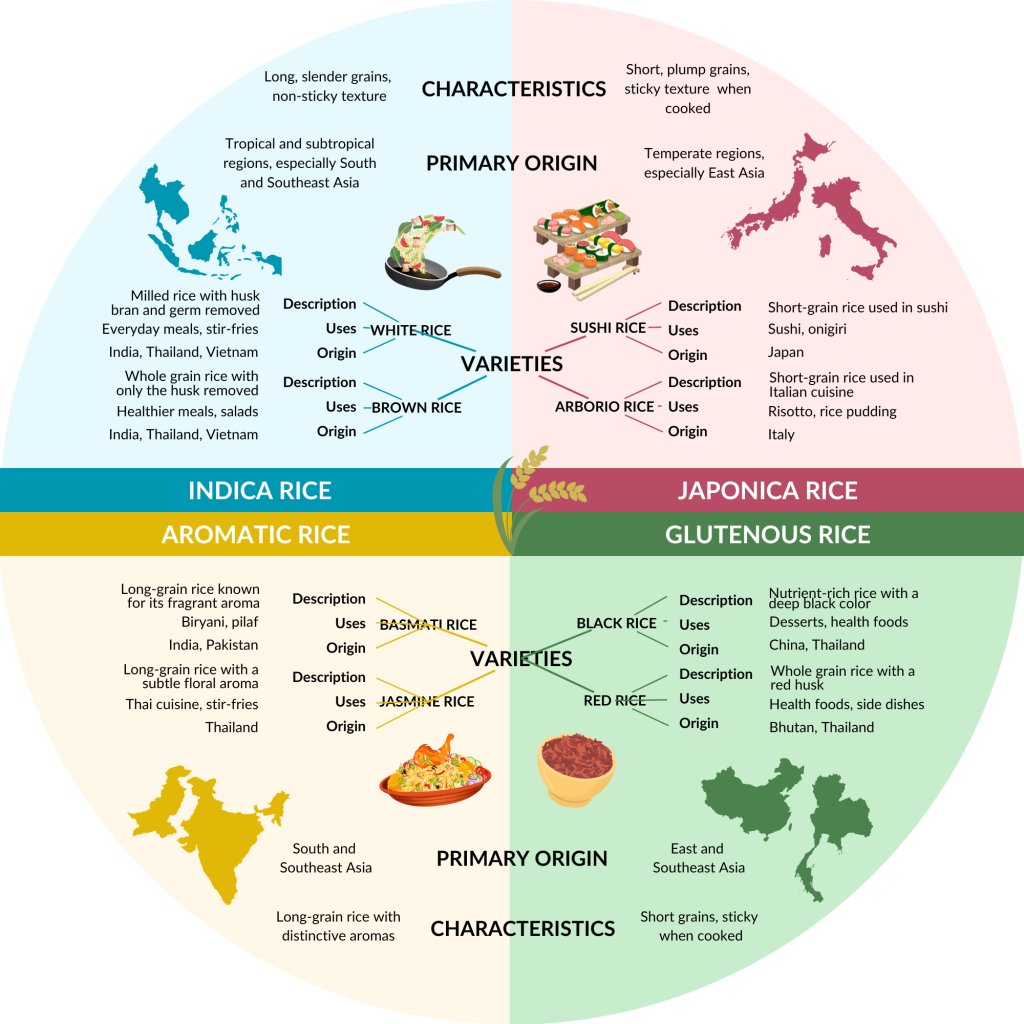
Source: GloballyCool, July 2024
Rice is covered in Chapter 1006 of the Harmonised System (HS), which includes the following paragraphs.
- 100610 Paddy rice (includes the inedible husk)
- 100620 Brown rice (husked)
- 100630 White rice (semi-milled, wholly milled, whether or not polished or glazed)
- 100640 Broken rice
Paragraphs 100620 and 100630 are used for trade statistics in this report. Speciality rice is part of these two codes (brown and white rice). However, note that the aggregated volumes for brown and white rice also include all other non-speciality rice varieties imported to Europe.
The bran is always intact in brown rice and coloured rice. White rice is milled, meaning the husk, bran and germ are removed. After milling, rice can be polished, resulting in a seed with a bright, white and shiny appearance. Rice can also be parboiled. This mean it is partially boiled in the husk, preserving most of its nutrients. Black and purple rice are mainly glutinous, while most red rice is of the indica variety.
Different consumers value different qualities. European consumers consider broken rice an inferior by-product of rice processing. Comparatively, Asian consumers appreciate its affordability, quick cooking and ability to absorb flavour. Broken rice is also used in products that need further processing, such as cereals, beer, starch, flours and pet food. Paddy rice (in the husk) is mostly traded for seeding and purposes other than direct consumption.
Tips:
- Read more about rice classification in the European market on the Access2Markets to better determine the custom duty rates and non-tariff measures applicable to your rice.
- Check out Taste Atlas: Rice of the World Map to see different rice varieties, where they come from and a brief profile.
2. What makes Europe an interesting market for specialty rice?
Speciality rice has received more attention over the past five years, in line with the growing consumption of rice in Europe as in general. Consumers want alternatives to traditional staples, driven by health trends and the popularity of Asian and Mediterranean cuisines. Underlying factors like income levels, preferential market access for exporters from several developing countries and a range of distribution channels have created stable demand, making Europe an attractive destination for speciality rice exporters.
Figure 2: Organic and Fairtrade certified rice in a German supermarket
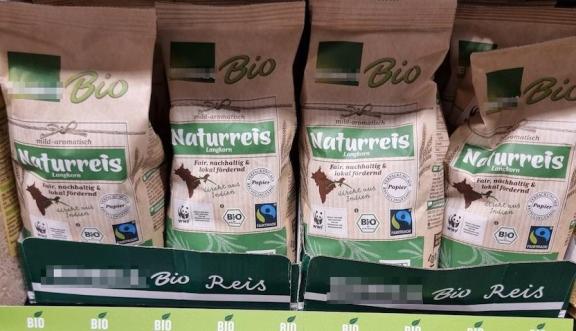
Source: GloballyCool, July 2024
Europe’s production of rice is insufficient
Europe’s rice consumption is so large that locally produced rice from southern Europe is not enough to satisfy total consumption. As a result, Europe is a net importer of rice from outside Europe, mainly from Asia.
At the same time, average rice consumption in Europe (6 kg per capita per year) is much lower than the global average of more than 50 kg per capita. That said, within Europe, per capita consumption shows significant variation. In northern and western Europe, the average is between 3 and 6 kg. In southern Europe, it varies from 6 to more than 15 kg per person.
Europe is a net-importer of indica rice
The traditional rice in Europe is japonica. It accounts for most of Europe’s rice production. Japonica rice is mainly produced and consumed in southern Europe. Comparatively, indica rice, or ‘traditional’ Asian rice, needs to be imported from outside Europe. Indica rice is a broader category. It includes many varieties, including the long-grain and aromatic varieties basmati and jasmine. These varieties are considered speciality rice, although their consumption volumes are considerable.
Source: GloballyCool, based on UN Comtrade statistics, June 2024
Europe is a stable rice market with above-average growth for speciality rice
Annual average rice consumption in Europe is expected to remain relatively stable at about 6 kg over the next few years. Imports will remain necessary as local production is not sufficient.
The speciality rice market is and will remain relatively small. However, its growth will remain higher than the mainstream market, supported by trends that drive the consumption of special rice varieties that offer health benefits, provide culinary experiences and are produced sustainably.
There are good opportunities for exporters who offer unique rice varieties along with a strong Unique Value Proposition (UVP). Opportunities are also better for exporters from countries that have preferential market access and exporters who have obtained sustainability certification (i.e. organic and Fairtrade).
Speciality rice exporters should focus on exporting milled rice because it is lighter so has lower transport costs. Further, milled rice is less sensitive to mycotoxin growth. Moreover, milling is an added-value process and can increase profit margins in the country of origin.
Northwest and South Europe are the most interesting regions
Northwest Europe generally has higher income levels than other European regions. This means consumers can afford specialty and higher priced rice varieties. The trends in dietary restriction and lifestyle choices drive this willingness to pay for quality and variety.
Tips:
- Stay up to date with developments in the rice trade through news sites like Rice News Today and World-Grain.com. Use the search function at the top to find rice related news.
- Follow the news of the European Civil Dialogue Group on Agricultural Markets for Rice for information on the rice market situation in Europe and potential trade policy modifications.
3. Which European countries offer the most opportunities for speciality rice?
The United Kingdom is the largest importer of rice from developing countries. France and Germany lead in terms of consumption and imports of organic rice. The Netherlands is an important entry point. Spain and Italy are important rice milling countries that increased their imports due to decreased local production.
Source: GloballyCool, based on UN Comtrade statistics (June 2024)
United Kingdom: leading importer of rice from developing countries
The United Kingdom is the biggest rice importer in Europe and the largest importer of rice from developing countries. Rice is not traditionally grown in the UK, nor do the British traditionally eat a lot of rice. It is the United Kingdom’s considerable ethnic population of south Asians that makes the country such a large importer of rice and sets favourable conditions for the speciality rice market too.
The United Kingdom’s rice imports peaked in 2020 and 2023. The average annual growth in the 2019–2023 period was 4.8%. Direct imports from developing countries increased by 8.8% per year, while imports from other European countries decreased by 13%.
Following Brexit, the United Kingdom can now create its own trade agreements. One consequence of Brexit is that the United Kingdom now relies less on intra-European sources. This can be seen in its declining rice imports from Netherlands (from 26,000 tonnes in 2019 to less than 500 tonnes in 2023) and Belgium (from 15,000 tonnes in 2019 to almost nothing).
Most of its imports were from India and Pakistan, with an average 47% share of total rice imports each year between 2019 and 2023. Most of the imported rice is basmati, used in Indian and Pakistani traditional cuisine. Most striking are the growing brown rice imports from Uruguay (+47% per year on average), Argentina (+45%) and Paraguay (more than 100% growth per year), which have compensated for the shrinking imports from Spain and Italy.
British consumers are very interested in international cuisines, including Asian, Middle Eastern and Latin American dishes that utilise specific rice varieties. The strong interest in speciality rice in the United Kingdom is linked to the large ethnic population in British society. A 2021 census showed that ethnic minority backgrounds made up approximately 18% of the total population, mostly from south Asia.
Most specialty rice is sold through mainstream retail channels. The most important rice brands in this channel are Ben’s Original (a division of Mars Incorporated) and Tilda (part of Ebro Foods). Brands like Tilda and Laila specialise in premium rice varieties, with particular emphasis on aromatic basmati rice. Companies, such as Ben’s Original and Veetee, focus more on the convenience market.
The United Kingdom is the fifth largest market for organic-certified products in Europe. Organic rice is sold in specialised organic retail chains, such as Whole Foods, Planet Organic and several mainstream supermarkets. Fairtrade certified rice is less available in physical outlets but can be bought relatively easily online through online shops, such as Premcrest and One World Shop (which sells rice from Malawi).
The ethnic food retail segment is relatively well developed in the United Kingdom. One example of a specialised Asian food retailer is Wing Yip, which has four stores across the UK. Wing Yip focuses on Chinese products, but it also stocks other Asian food products, including speciality rice. One example of an online shop for Asian food products in the United Kingdom is Red Rickshaw.
France: main European importer of white and fragrant rice
France is the second largest European importer of rice, behind the United Kingdom, but far ahead of Germany and the Netherlands. Imports from developing countries reached 230,000 tonnes in 2023. This is much less than the United Kingdom’s import volume from developing countries but equal to Spain’s. France is Europe’s largest importer of aromatic rice from Thailand and Cambodia.
France is also one of Europe’s main rice producers with an annual production of about between 70,000 and 80,000 tonnes (unprocessed paddy rice) of Riz de Camargue in Southern France. It is known for its unique flavour and texture. About 20% is organic certified. One example of a French Camargue rice supplier is Canavere.
Italy has been France’s main trading partner over the years. Between 2019 and 2023, French rice imports have been relatively stable, with Italy making up 27% of total imports. Italian risotto rice (arborio) is widely available in France and known for its high starch content that provides a creamy texture and significant flavour absorption.
Imports from developing countries accounted for 50% of French rice imports in 2023. However, there was a small average decline (-1.9% per year) between 2019 and 2023. More than 80% of the imported volume is white rice. White rice grew (+1.8% per year), while brown rice imports went down by -13% year on year. Most of white rice comes from Cambodia and Thailand. Pakistan is the leading supplier of brown rice to Italy, ahead of Uruguay and India.
The main speciality rice varieties are used in French cuisine and sold through conventional markets. The demand for diverse and unique rice varieties continues to grow, making France an interesting market for speciality rice. France’s culinary heritage and appreciation of high-quality ingredients drive interest in unique rice varieties and make France a large and growing market for organic food. One specialised retailer that reflects this phenomenon is La Grande Épicerie de Paris, which offers a considerable selection of speciality rice.
Speciality rice can be found in the large rice sections of the mainstream supermarkets, such as Carrefour, Intermarché and Auchan. Another category is stores that specialise in ethnic ingredients. These stores have a large selection of rice products. One example is Tang Frères (‘Tang Brothers’), an Asian supermarket chain with more than 20 stores in Paris.
France has one of Europe’s highest number of organic rice importers. This contributes to the importance of France as an organic market. France’s certified importers import rice directly. France is home to a number of specialised organic retail outlets, including Biocoop, Naturalia, La Vie Claire, Les Comptoirs de la Bio, Bio c’ Bon and NaturéO. So far, the fairtrade rice market is relatively small, which is also reflected by a relatively limited number of fairtrade-certified French importers of rice.
France will remain an interesting market for specialty rice for the next few years, organic and otherwise. Meanwhile, French consumers are very interested in the locally produced Riz de Camargue, recognising it as more sustainable and healthier.
Germany: largest organic market in Europe
Like several other northern European countries, Germany imports a lot of rice. After the peak in rice imports in 2020 caused by a record import volume from Italy, imports were relatively stable between 2021 and 2023. On average, rice imports went down slightly (-1.1% per year) in the 2019–2023 period.
Italy (35%), Belgium (14%) and the Netherlands (11%) are Germany’s primary rice suppliers while the leading non-European supplying countries are India (9%), Pakistan (6%) and Thailand (5%). The supplying countries with the largest growth in German exports between 2019 and 2023 are Vietnam (+39% growth per year, 5% total German imports in 2023) and India (+7.1% to a share of 9.2%).
Since 60% of Germany’s rice imports comes from Italy (35%), Belgium (14%) and the Netherlands (11%), a relatively small share is direct imports from developing countries (31%). Still, Germany imports considerable volumes of rice directly from origin countries, with the largest volumes coming from India (30,000 tonnes in 2023), Pakistan (19,300 tonnes), Thailand (17,100 tonnes), Vietnam (16,400 tonnes) and Cambodia (13,500 tonnes).
Rice consumption in Germany is relatively stable at around 6 kg per person annually. Germany is Europe’s largest organic food market, with organic food sales reaching more than 6% of the total food market in 2023. In the 2020–2023 period, speciality rice varieties became widely available, sold in specialised organic retail outlets, such as Alnatura anymore, and mainstream supermarkets, like EDEKA and REWE. At the same time, the total volume of speciality rice sold in mainstream channels is expected to stay far behind the volumes sold in specialised channels.
Figure 5: Organic and Fairtrade basmati rice from the Himalayan project ‘Khaddar’ sold in a German supermarket
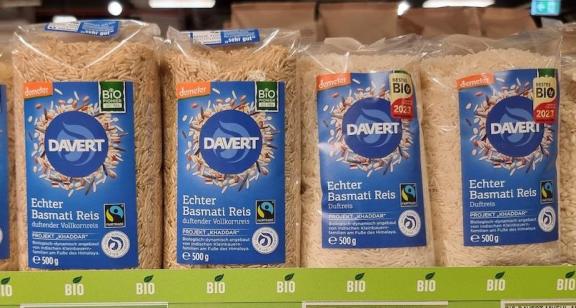
Source: GloballyCool, July 2024
The German market offers the most opportunities for white rice imports directly from their origins, particularly organic, Fairtrade and Demeter-certified varieties. These rice varieties include basmati, jasmine and wild rice. German consumers are increasingly seeking healthy and sustainable food choices, which aligns with speciality rice options and rice with extra protein.
Popular rice brands in the German mainstream market are Oryza and reis-fit. In general, the more special the rice, the more likely it can be found in organic and specialty stores. Well-known brands for Fairtrade rice include Davert, GEPA and Reismühle Brunnen/Nutrex. Rii Jii is a relatively new company offering organic and fairtrade-certified jasmine rice from Thailand, amongst other things.
So far, there are almost no Asian-oriented food retail chains in Germany. One relatively new initiative is Go Asia, which has six stores in Berlin, Frankfurt and Dusseldorf.
Tips:
- Find Fairtrade brands in Germany with the Fairtrade Germany product finder to find prospects in this niche market segment.
- Focus on companies that target niche segments including organic, Fairtrade and ethnic markets. This is because market growth outside specialised market segments may be relatively low.
Netherlands: European rice hub
The Netherlands is an important hub for rice imports into Europe. The import volume grew by 2.4% per year on average and peaked at more than 372,000 tonnes in 2022. More than 65% comes from developing countries. However, this share has been declining slightly as the United Kingdom reduced its exports of white rice processed in the Netherlands. About two-third of imports is white rice, with the remainder being brown rice.
The leading supplier of rice to the Netherlands is India (30%), followed by Pakistan (15%), Cambodia (11%) and Thailand (10%). Imports from India grew by 16% per year on average, at the cost of imports from Pakistan, down10% per year. The Netherlands has a relatively large number of immigrants from Indonesia (more than 360,000 people) and a sizeable population of immigrants from Suriname. These influences have contributed to the adoption of various rice types and products on Dutch supermarket shelves.
Dutch consumers appreciate quality and variety. This makes speciality rice an attractive option, especially if there are added health benefits. The multicultural nature of the Netherlands contributes to demand for different rice types, including basmati and jasmine rice (‘pandan rice’). The Netherlands’ strategic location also enables distribution to neighbouring countries, such as Germany, Belgium and France.
Figure 6: Specialty rice in a mainstream supermarket in the Netherlands
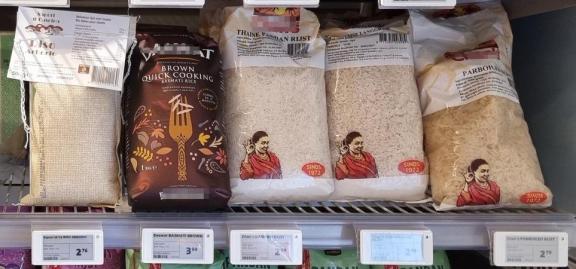
Source: GloballyCool, July 2024
Mainstream supermarkets like Albert Heijn offer a large range of rice products and varieties. However, most speciality rice is sold in specialty stores, including organic retailers like Ekoplaza and ethnic retail chains. The largest of these is Amazing Oriental, which has 25 stores and an online shop. There are also many smaller, often independent ethnic retail outlets, such as Thien Hung with two outlets in two different cities, and Asian Food Lovers.
Spain: highest growth in rice imports
Spain registered the highest annual rice import growth in Europe (+15% in 2019–2023). [A1] Usually, a lot of Spanish consumption is met by local production. However, the country experienced a decrease in rice production in 2022. As a result, Spain had to increase its rice imports. This resulted in significant growth of rice imports from Brazil (from 0 in 2019 to 33,000 tonnes in 2023), Uruguay (from 3.6 to 43,000 tonnes) and India (from 1.9 in 2019 to 9,400 tonnes).
One factor that led to growing rice imports was the extreme weather conditions that drastically affected rice production in 2022. Another factor is the steadily growing rice consumption in Spain. This growth is set to continue in the next few years. The country is home to an immigrant population of mostly south American origins, while the population of Asian diaspora is relatively limited compared to other European countries.
Most rice in Spain is sold through the mainstream food retail segment (90%). Only a small part (10%) is sold through specialised shops. For specialty rice, the balance is different: 75% is sold through the mainstream food retail segment and 25% through specialised shops.
The largest mainstream food retail chain by far is Mercadona. Mainstream food retailers have large rice sections. A lot of space is dedicated to paella and locally produced rice. Speciality rice varieties are also available, often in bags of 1 kg.
Speciality food stores offer a wide range of specialty rice. Examples include organic food retailers like Veritas, ethnic shops like OneSupermarket, bulk food ingredient stores like Casa Ruiz and online shops like Your Spanish Shop.
[A2] Consumer preferences for rice varieties differ throughout the country. Consumer preferences also relate to what kind of rice is produced regionally. Short-grain rice is preferred in coastal regions. Long-grain varieties are preferred in southern Spain, as these varieties are mainly cultivated there. Short-medium-grain rice varieties are more cultivated and preferred in northeast Spain.
Figure 7: Organic rice in 1 kg packages in a Spanish organic supermarket
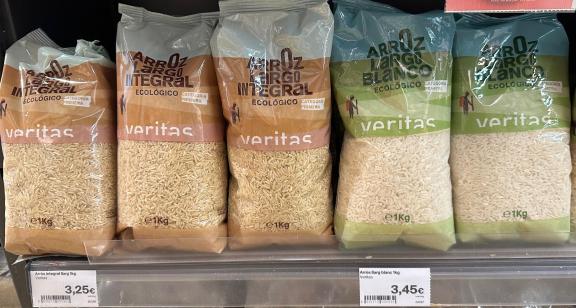
Source: GloballyCool, July 2024
Italy: leading rice producer in Europe
Italy is Europe’s main rice producer, accounting for about 50% of European production. It is one of Europe’s top seven importers of rice from outside Europe over the period 2019–2023. Italy’s rice production is mainly japonica rice, accounting for around 75%, with the other 25% being indica rice varieties. Italy imports more than 85% of its rice directly from developing countries. This share is amongst the highest in Europe.
Italian rice production has been relatively stable for a long time but, like Spain, Italy faced multiple challenges in 2022. Italy experienced its driest year on record, decreasing rice production by 20%. This resulted in a peak in white rice imports in 2022. Supplying countries that increased their rice export to Italy included Myanmar, Cambodia, Vietnam and the Netherlands. Imports from outside Europe went down again in 2023, as production volumes recovered.
Most of Italy’s rice imports come from Pakistan (40% share in 2023), followed by India (15%), Thailand (11%), Myanmar (10%) and Cambodia (9.3%). Imports from Myanmar (+48% per year), Cambodia (+32%) and India (+20%) increased significantly, but rice imports from Pakistan and Thailand also grew 7–9% year on year. One-third of Italy’s rice imports is brown rice, with the remainder being white rice.
The Italian rice market is relatively large because of the high per capita consumption (9 kg per year compared to an EU average of 6 kg). Risotto is one of the most important Italian dishes for which rice is a key element. While traditional risotto rice varieties like arborio and carnaroli dominate the Italian market, there is demand for special indica rice varieties.
Aromatic varieties like basmati and jasmine can complement Italian cuisine, especially in fusion dishes. The Italian market appreciates authenticity and quality, making it receptive to speciality rice options. Italy’s import of husked rice is mainly made up of basmati rice imported from Pakistan and India (approximately 50,000 tonnes per year).
Most rice is sold through mainstream food retailers like Conad, Coop Italy and Esselunga. While Coop and Esselunga have grown organic rice sales under their own organic brands, the largest volume of organic rice is sold through specialised organic retail chains, such as NaturaSì.
Italy is an important player in the European rice industry. Most importantly, Italy is home to European Rice Company (Euricom), Europe’s largest rice company, which has all over in Europe. Several rice mills in Italy, including Agrover and Mundiriso, blend local Italian rice with imported aromatic rice varieties. Agrover’s latest line of products is a mix of rice, legumes, flours and preparations. It shows how Italian companies also tap into the European market trends for healthier and protein-rich food options.
Italy is home to quite a large immigrant population. In addition to a group from Middle Eastern countries (almost 600,000), it is also home to immigrants from China (about 275,000), the Philippines (about 175,000; the largest Filipino diaspora in Europe), India (about 150,000), Bangladesh (about 120,000), Sri Lanka (about 100,000) and Pakistan (about 100,000). This population has contributed to the country’s growing ethnic food retail segment, reflected by independent online shops like Asia-Market and large Asian food retail stores like Kathay in Milan, which focuses on food and related products from China, Japan, India, the Middle East and Thailand.
Tips:
- Adapt to your target market’s preferences or focus on the market with the most potential for your specific product. For example, prioritise the British market if you want to sell husked basmati rice, but focus on France and Germany first if you offer organic rice.
- Get more specific information about potential buyers from different countries by visiting trade fairs in Europe, such as SIAL and Anuga for the mainstream food industry.
- Consider visiting the world’s leading organic event, hosted every year in Germany: BIOFACH. It is especially worthwhile if your offer consists of rice with sustainable certification.
4. Which trends offer opportunities or pose threats in the European market?
The European speciality rice market is driven by increasing exposure to foreign cuisines, improved availability in mainstream supermarkets and growing interest in healthy and sustainably certified rice. These trends mainly affect the market in northwest Europe, but they also play a role in southern European countries.
Ongoing exposure to foreign cuisines drives speciality rice consumption
The ongoing exposure of Europeans to different food cultures is an important driver of the speciality rice market. This exposure takes place both outside Europe (on holiday) and in Europe (indirectly, through the ethnic population). Exposure is a driver of speciality rice consumption, as each special rice variety carries the unique taste and character of the place it comes from. Gourmet enthusiasts trace culinary experiences and appreciate the distinctiveness of speciality rice along with its origin, which adds depth and meaning to their dining experience.
Unique nutrition profiles create interest
Compared to normal brown and white rice, several speciality rice varieties have unique nutrition profiles. This makes speciality rice attractive to health-conscious consumers. Red rice, for example, has high levels of anthocyanins and antioxidants that promote haemoglobin formation. Some varieties are rich in iron and zinc, which provides a stronger immune function and healing. Black rice has the best antioxidant benefits in comparison to normal rice varieties.
Speciality rice moves from the niche to the mainstream segment
The European rice market is undergoing a significant shift. Speciality rice is no longer only sold in niche market segments, like specialised organic stores or ethnic retail markets. It is also increasingly sold in the mainstream retail segment.
Stores like REWE in Germany and Jumbo in the Netherlands have increased the number of speciality rice products in their outlets. This makes these products available to consumers who do not usually visit specialised shops. As a result, consumers can now find a diverse selection of speciality rice varieties in their local supermarkets, catering to potential needs for healthier and more environmentally friendly food options.
Although the supermarkets in northwest Europe are largely frontrunners in the adoption of specialty and organic rice, supermarkets in southern Europe have also followed this trend, introducing more special basmati, jasmine, black, red and organic rice.
Sustainably certified rice keeps on gaining interest from consumers
European buyers are paying more attention to social and environmental sustainability. Businesses are showing interest in rice suppliers in origin countries employing sustainable practices and being transparent. This involves many areas, including working conditions, water use and waste management. European buyers are more likely to be interested in your product if it follows sustainability guidelines.
Organic certification
Organic certification is the most important sustainability certification for rice in Europe. You need specific organic certification for the EU market. Organic rice exported to Europe has to comply with Regulation (EU) 2018/848. The total volume of organic rice imported to Europe is about 90,000 tonnes per year.
Figure 8: Organic specialty rice in a Dutch organic supermarket
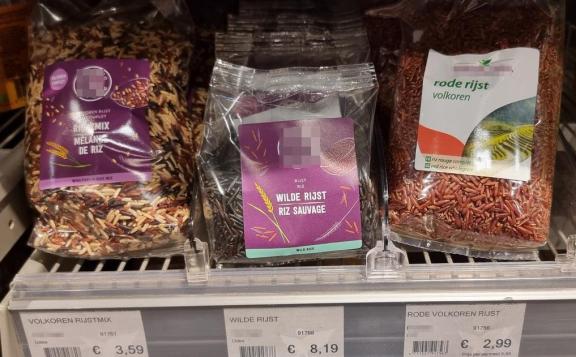
Source: GloballyCool, July 2024
Sustainably certified rice
Atlas Foods is a leading producer, processor and exporter of basmati rice from Pakistan. It effectively tapped into the growing European demand for sustainably certified rice. Atlas Foods has been a member of the Sustainable Rice Platform (SRP) since 2019. Atlas Foods helps local communities by increasing farmers’ income and creating better job opportunities. This helps reduce poverty, improve rural areas and ensure social equity. Atlas Foods understands the need to provide fair wages, safe working conditions and support growth for everyone in the rice industry.
Atlas Foods recognised the increasing consumer interest in environmentally and socially responsible food products. As a result, it adopted sustainable farming practices and earned various certificates, such as organic (both for Europe and the US), SRP verification and Fairtrade (FLO ID: 44651). These certificates show European consumers that the rice they purchase meets high standards of environmental sustainability and social responsibility.
The company has invested heavily in modern processing facilities that enhance the quality and safety of their basmati rice and reduce the environmental impact of their operations. Atlas Foods employs state-of-the-art technology to minimise water use, reduce waste and ensure efficient energy consumption.
By maintaining strict quality control measures throughout their production process, Atlas Foods guarantees that their rice keeps its superior taste and nutritional value. This appeals to European buyers and health-conscious consumers. Atlas Foods obtained an ISO22000 certification for food safety management, which shows their ambition. Keep in mind, however, that ISO22000 is not an internationally recognised certification (FSSC 22000 is).
Atlas Foods’ commitment to sustainability has also opened premium markets in Europe. By aligning their products with European consumers’ ethical values, the company has successfully penetrated mainstream retail segments and premium organic food stores across the continent. The growing trend of sustainably certified rice has not only boosted Atlas Foods’ reputation but also contributed to increased sales and market share in Europe. This strategic focus on sustainability positions Atlas Foods as a role model in the global rice industry.
Fairtrade certification
The fairtrade market is based on Fairtrade certification. Every player in the supply chain needs to be certified to participate in this market, and certification is done by independent parties. Fairtrade International has a specific standard for small-scale producer organisations of cereals, Fairtrade Standard for Cereals, which includes rice. Secondary products and their derivatives are also covered. This standard defines minimum prices and price premiums for conventional and organic rice from several countries and regions.
The global fairtrade market is transparent. You can find importers and other players in this market using the FLOCERT database, the global certification body for the Fairtrade supply chain. In the European market, in supermarkets, you can find private label products with the Fairtrade logo. However, there are also several brands whose product offering is sometimes up to 100% Fairtrade, including FairGlobe (Lidl’s brand for Fairtrade certified products), Fairtrade Original from the Netherlands, Oxfam Fair Trade from Belgium, Claro from Switzerland and GEPA from Germany.
In total, there are 33 certified producer organisations worldwide. Most of them are from India (16), followed by Thailand (8), Pakistan (5) and Sri Lanka (4) (as of July 2024, according to the FLOCERT database).
In the European market, there are 85 Fairtrade certified importers/traders, most of which are from Italy (15), Germany (13), Switzerland (7), Austria and France (both 5). The Netherlands (4), Belgium (3) and Spain (2) are also home to multiple Fairtrade certified companies.
One of the major players in Fairtrade rice is Reis Mühle Brunnen (RMB). This is a rice mill and packer that has become part of Coop, one of the biggest supermarkets in Switzerland. Alter Eco in France and Davert in Germany have also seen success with Fairtrade rice.
Tips:
- Talk with your buyers and determine if and what certification scheme might be relevant to your target market.
- Check the SRP step-by-step guide to getting SRP-verified to see your roadmap towards certification if you want to become a sustainable rice producer.
- Turn the trend for more sustainably produced products to your advantage by making sustainability a priority in your company. By doing this, you can stand out from other suppliers. Learn from best practices, such as the case of Atlas Foods.
Globally Cool carried out this study on behalf of the CBI.
Please review our market information disclaimer.
Search
Enter search terms to find market research
